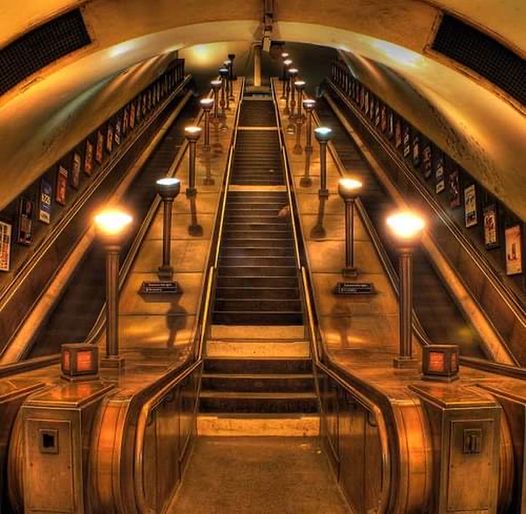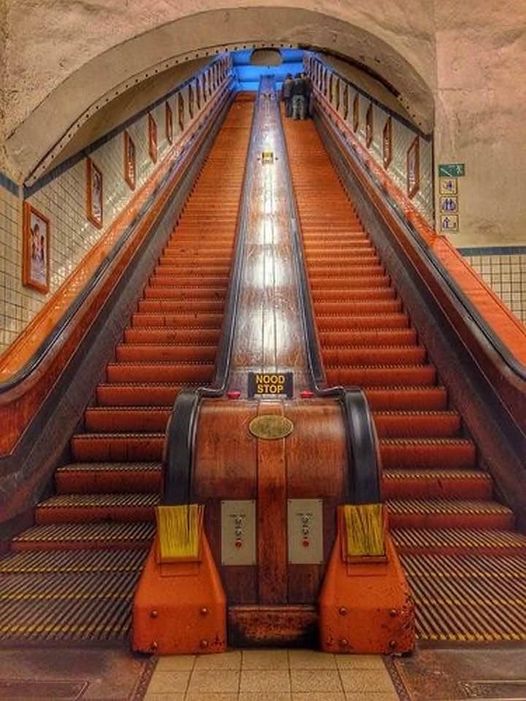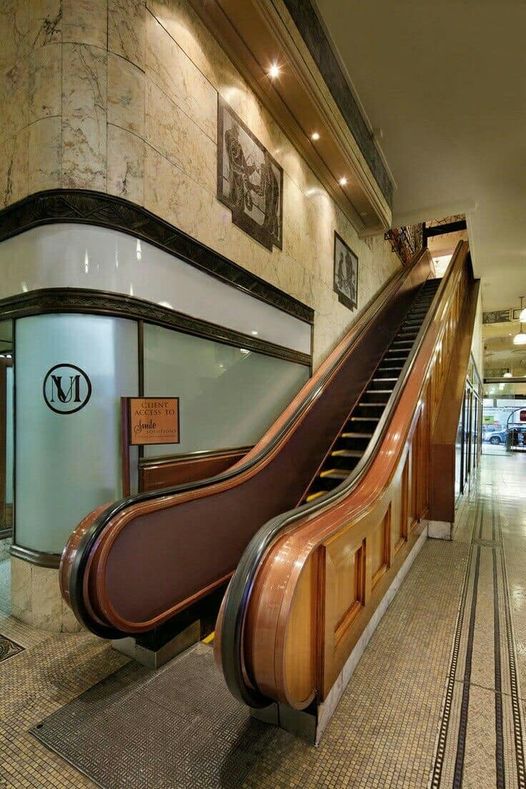Art Deco is a design style that originated in the 1920s and 1930s, characterized by sleek lines, geometric shapes, and a sense of luxury and modernity. While escalators themselves are generally functional structures, the surrounding architecture and design elements can incorporate Art Deco aesthetics to enhance the overall visual appeal.

A charming wooden escalator in the iconic Macy’s department store in Manhattan.
This antique people-mover, built by the Otis Elevator Company ,(which pioneered the machinery) between 1920 and 1930, is not your average modern escalator. With a distinctive Art Deco design and a Steampunk/Dieselpunk feel, it’s a unique experience that transports you to a bygone era.
These wooden escalators can still be found in good working condition at Macy’s Herald Square, the world’s largest department store.
When the store underwent major renovations in 2015, many of its old-world features were upgraded to their modern versions. However, a few wooden escalators stayed put.
The nearly century-old escalators were made of sturdy oak and ash, wood that’s traditionally used in hardwood flooring. The mechanical parts have, of course, been upgraded, and modern safety measures have been put in place.
As of October 2016, the wooden slatted escalators on the lower floors were replaced with metal stairs, only the top 2 floors remain wooden. All wonder how long they’ll last.
Via History Daily Org
Photograph ©2022 by Brian Cohen.

Wooden Escalator in Southgate Tube Station London
Work of Charles Holden, the architect behind Southgate Tube Station, one of London’s finest Art Deco Underground stations.
Southgate station opened on 13 March 1933.
The station is built in the Art Deco/Streamline Moderne design .
The original escalators were replaced in the late 1980s with the then standard London Transport design. The balustrade of the escalators was manufactured from bronze, rather than aluminium to maintain the 1930s period appearance of the station and to satisfy the requirements of English Heritage.
The preserved condition of the station’s original features, particularly the escalators, makes Southgate popular for filming scenes for period dramas.

Macy’s Wooden Escalators
Manhattan, New York
A bit of retro transportation flair preserved in the world’s largest department store.
The escalators were built between 1920 and 1930 by the Otis Elevator Company, which pioneered the machinery. They’re made of sturdy oak and ash, wood that’s traditionally used in hardwood flooring. The mechanical parts have, for the most part, been updated, and modern safety measures have been put in place.
They might be updated and maintained regularly as per modern standards, but the nearly century-old escalators aren’t going anywhere, despite how much they might creak.
Present time :
Update as of October 2016: Only the escalator treads on the top two floors remain wooden.
Update as of January 2020: The escalator treads from the fifth through ninth floors remain wooden.
Update as of July 2021: The escalator treads in the escalators near the elevators and women’s restroom are wooden from the second through ninth floors. The other escalator is modern at least on the lower floors.

Art Deco Wooden Escalator, Antwerp,Belgium from 1930
MAJESTIC WOODEN ESCALATORS LEAD YOU deep down into a tunnel that stretches beneath the Scheldt River. They’re the highlight of the otherwise staggeringly monotonous 1,876 feet of ceramic tiles that backdrop your walk from shore to shore.
The escalators were made in the 1930s. They were a novelty then and still are now, thanks to the rarity of wooden escalators. The beautiful woodwork is remarkably preserved, making this a real treat for anyone tired of the modern, more unsightly escalators that dominate pretty much everywhere else.

Art Deco Wooden Escalator at the
Pedestrian Tunnel of St. Anna’s Tunnel – Antwerp, Belgium
These majestic wooden escalators lead you deep down into a tunnel that stretches beneath the Scheldt River .It was opened in 1933.
The escalators are the highlight of the otherwise staggeringly monotonous 1,876 feet of ceramic tiles that backdrop your walk from shore to shore.
They were a novelty then and still are now, thanks to the rarity of wooden escalators. The beautiful woodwork is remarkably preserved, making this a real treat for anyone tired of the modern, more unsightly escalators that dominate pretty much everywhere else.
St. Anna’s Tunnel was built to connect the newer parts of Antwerp with the older portion of the city ,so locals wouldn’t have to rely on ferry service alone. Originally, plans were made to build a bridge over the river. But this would’ve gotten in the way of the many ships that cruise the waterway, so officials decided to build under rather than over it.
As with many European structures, the tunnel was badly damaged during World War II. The passage has since been repaired, and it and its unusual escalators are still frequently used by pedestrians and cyclists as they go about their daily commutes.

Detail of The Manchester Unity Building
Melbourne, Victoria, Australia
The Manchester Unity Building is one of Melbourne’s most iconic art deco landmarks. It was built in 1932 for the Manchester Unity Independent Order of Odd Fellows (IOOF), a friendly society providing sickness and funeral insurance.
Architect Marcus Barlow
Photo Helen Rose
 pyomn
pyomn



